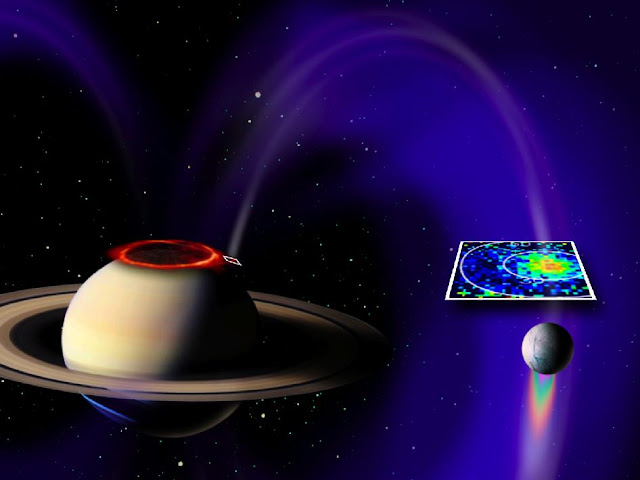Electrical Circuit Between Saturn and Enceladus
A larger white square above Enceladus shows a cross-section of the magnetic field line between the moon and the planet. This pattern of energetic protons was detected by Cassini's magnetospheric imaging instrument (MIMI) on Aug. 11, 2008.
The patch near Saturn's north pole glows because of the same phenomenon that makes Saturn's well-known north and south polar auroras glow: energetic electrons diving into the planet's atmosphere. However, the "footprint" is not connected to the rings of auroras around Saturn's poles (shown as an orange ring around the north pole in this image).
The Cassini plasma spectrometer complemented the MIMI data, with detection of field-aligned electron beams in the area. A team of scientists analyzed the charged particle data and concluded that the electron beams had sufficient energy flux to generate a detectable level of auroral emission at Saturn. Target locations were provided to Cassini's ultraviolet imaging spectrograph team. On Aug. 26, 2008, the spectrograph obtained images of an auroral footprint in Saturn's northern hemisphere.
The newly discovered auroral footprint measured about 1,200 kilometers (750 miles) in the longitude direction and less than 400 kilometers (250 miles) in latitude, covering an area comparable to that of California or Sweden. It was located at about 65 degrees north latitude.
In the brightest image the footprint shone with an ultraviolet light intensity of about 1.6 kilorayleighs, far less than the Saturnian polar auroral rings. This is comparable to the faintest aurora visible at Earth without a telescope in the visible light spectrum. Scientists have not yet found a matching footprint at the southern end of the magnetic field line.
The background star field and false color images of Saturn and Enceladus were obtained by Cassini's imaging science subsystem.
The Cassini-Huygens mission is a cooperative project of NASA, the European Space Agency and the Italian Space Agency. NASA's Jet Propulsion Laboratory, a division of the California Institute of Technology in Pasadena, Calif. manages the mission for NASA's Science Mission Directorate, Washington, D.C. The ultraviolet imaging spectrograph team is based at the University of Colorado, Boulder. The magnetospheric imaging team is based at the Johns Hopkins University Applied Physics Laboratory, Laurel, Md. The Cassini plasma spectrometer team is based at the Southwest Research Institute, San Antonio, Texas.


टिप्पणियाँ
एक टिप्पणी भेजें